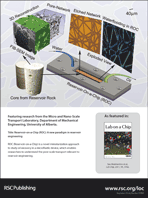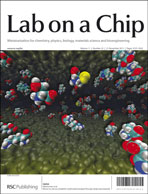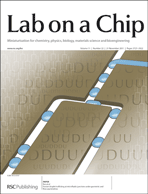This month sees the following articles in Lab on a Chip that are in the top ten most accessed:
Integration of cell phone imaging with microchip ELISA to detect ovarian cancer HE4 biomarker in urine at the point-of-care
ShuQi Wang, Xiaohu Zhao, Imran Khimji, Ragip Akbas, Weiliang Qiu, Dale Edwards, Daniel W. Cramer, Bin Ye and Utkan Demirci
Lab Chip, 2011, 11, 3411-3418
DOI: 10.1039/C1LC20479C
Paper on a disc: balancing the capillary-driven flow with a centrifugal force
Hyundoo Hwang, Seung-Hoon Kim, Tae-Hyeong Kim, Je-Kyun Park and Yoon-Kyoung Cho
Lab Chip, 2011, Advance Article
DOI: 10.1039/C1LC20445A
Microfluidics with aqueous two-phase systems
Steffen Hardt and Thomas Hahn
Lab Chip, 2011, Advance Article
DOI: 10.1039/C1LC20569B
Large-scale plasmonic microarrays for label-free high-throughput screening
Tsung-Yao Chang, Min Huang, Ahmet Ali Yanik, Hsin-Yu Tsai, Peng Shi, Serap Aksu, Mehmet Fatih Yanik and Hatice Altug
Lab Chip, 2011, 11, 3596-3602
DOI: 10.1039/C1LC20475K
Education: A modular approach to microfluidics in the teaching laboratory
Yolanda Fintschenko
Lab Chip, 2011, 11, 3394-3400
DOI: 10.1039/C1LC90069B
Automated high-throughput generation of droplets
Jan Guzowski, Piotr M. Korczyk, Slawomir Jakiela and Piotr Garstecki
Lab Chip, 2011, 11, 3593-3595
DOI: 10.1039/C1LC20595A
Rounded multi-level microchannels with orifices made in one exposure enable aqueous two-phase system droplet microfluidics
David Lai, John P. Frampton, Hari Sriram and Shuichi Takayama
Lab Chip, 2011, 11, 3551-3554
DOI: 10.1039/C1LC20560A
Microchip-based immunomagnetic detection of circulating tumor cells
Kazunori Hoshino, Yu-Yen Huang, Nancy Lane, Michael Huebschman, Jonathan W. Uhr, Eugene P. Frenkel and Xiaojing Zhang
Lab Chip, 2011, Advance Article
DOI: 10.1039/C1LC20270G
A digital microfluidic method for dried blood spot analysisMais J. Jebrail, Hao Yang, Jared M. Mudrik, Nelson M. Lafrenière, Christine McRoberts, Osama Y. Al-Dirbashi, Lawrence Fisher, Pranesh Chakraborty and Aaron R. Wheeler
Lab Chip, 2011, 11, 3218-3224
DOI: 10.1039/C1LC20524B
Green microfluidic devices made of corn proteins
Jarupat Luecha, Austin Hsiao, Serena Brodsky, Gang Logan Liu and Jozef L. Kokini
Lab Chip, 2011, 11, 3419-3425
DOI: 10.1039/C1LC20726A
Why not take a look at the articles today and blog your thoughts and comments below.
Fancy submitting an article to Lab on a Chip? Then why not submit to us today or alternatively email us your suggestions.
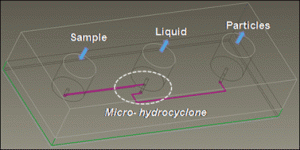 Hydrocyclones are widely used in industries such as petrochemicals and mining for the separation of particulates from fluids at the macro- and mesoscale. This is the first report of microscale hydrocyclone, tested on polystyrene microbeads suspended in PBS, providing continuous separation with exceptional flow rates and without clogging. Microfluidic applications potentially include chemical analysis, materials research, point-of-care and blood sample preparation.
Hydrocyclones are widely used in industries such as petrochemicals and mining for the separation of particulates from fluids at the macro- and mesoscale. This is the first report of microscale hydrocyclone, tested on polystyrene microbeads suspended in PBS, providing continuous separation with exceptional flow rates and without clogging. Microfluidic applications potentially include chemical analysis, materials research, point-of-care and blood sample preparation.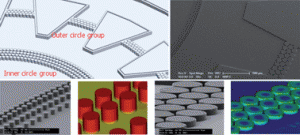 Cyclic olefin copolymer has been used to create a whole microfluidic device through microinjection moulding with the aim of bridging the gap between lab techniques and mass production of lab on a chip devices. The team that successfully developed the platform have also come up with a dimensionless number μf to provide an insight into the physics of microinjection moulding.
Cyclic olefin copolymer has been used to create a whole microfluidic device through microinjection moulding with the aim of bridging the gap between lab techniques and mass production of lab on a chip devices. The team that successfully developed the platform have also come up with a dimensionless number μf to provide an insight into the physics of microinjection moulding.










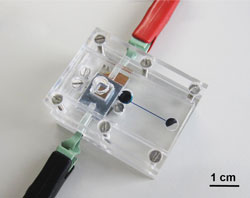
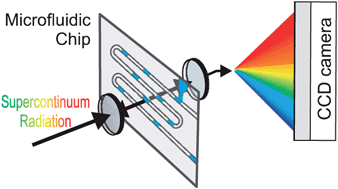
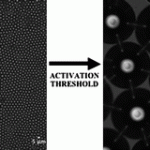
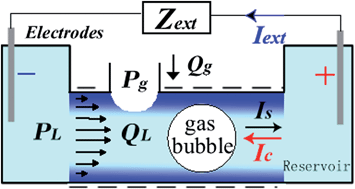
_410_tcm18-209087.jpg)

